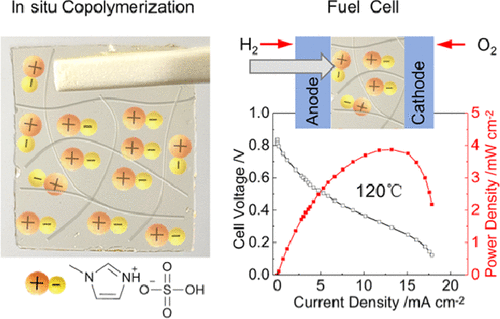当前位置:
X-MOL 学术
›
Ind. Eng. Chem. Res.
›
论文详情
Our official English website, www.x-mol.net, welcomes your
feedback! (Note: you will need to create a separate account there.)
In Situ Polymerized Protic Ionogels for Fuel Cells at Elevated Temperatures
Industrial & Engineering Chemistry Research ( IF 3.8 ) Pub Date : 2021-03-01 , DOI: 10.1021/acs.iecr.0c04882 Mengdou Zou 1 , Jie Luo 1 , Xurui Wang 1 , Shuai Tan 1 , Caihong Wang 1 , Yong Wu 1
Industrial & Engineering Chemistry Research ( IF 3.8 ) Pub Date : 2021-03-01 , DOI: 10.1021/acs.iecr.0c04882 Mengdou Zou 1 , Jie Luo 1 , Xurui Wang 1 , Shuai Tan 1 , Caihong Wang 1 , Yong Wu 1
Affiliation

|
Dimethylethylammonium hydrogen sulfate ([DMEA][HSO4]) and 1-methylimidazoilum hydrogen sulfate ([MIM][HSO4]) as protic ionic liquids are intrinsically proton conductive due to available protons on both cations and anions. Protic ionogels are prepared via in situ radical copolymerization of acrylamide, 2-acrylamide-2-methylpropanesulfonic acid, and divinylbenzene in [DMEA][HSO4] and [MIM][HSO4] for fuel cell application. Ionogels could be stretched to twice their original length with a fracture stress of 20 kPa. Proton conduction in the protic ionogels is dominated by the vehicle mechanism and the conductivity reaches a maximum of 17.1 mS cm–1 at 120 °C. The ionogel resulted from [MIM][HSO4] is thermally more stable than that from [DMEA][HSO4] and fabricated into an ionogel electrode assembly for a H2/O2 fuel cell. A single fuel cell exhibits a peak power density of 3.9 mW cm–2 under nonhumidified conditions. In situ polymerization of vinyl monomers in protic ILs offers an efficient strategy to construct soft electrolytes toward proton conduction at elevated temperatures.
中文翻译:

高温下用于燃料电池的原位聚合质子离子凝胶
质子性离子液体的硫酸二甲基乙铵硫酸氢盐([DMEA] [HSO 4 ])和1-甲基咪唑硫酸氢盐([MIM] [HSO 4 ])本质上是质子导电的,这是由于阳离子和阴离子上都有可用的质子。质子离子凝胶是通过在[DMEA] [HSO 4 ]和[MIM] [HSO 4 ]中将丙烯酰胺,2-丙烯酰胺-2-甲基丙烷磺酸和二乙烯基苯进行自由基共聚制备的,用于燃料电池。离子凝胶可以以20 kPa的断裂应力拉伸至其原始长度的两倍。质子离子凝胶中的质子传导受媒介机制支配,在120°C时电导率最高达到17.1 mS cm –1。离子凝胶是由[MIM] [HSO 4]比[DMEA] [HSO 4 ]具有更高的热稳定性,可制成用于H 2 / O 2燃料电池的离子凝胶电极组件。在非加湿条件下,单个燃料电池的峰值功率密度为3.9 mW cm –2。质子ILs中乙烯基单体的原位聚合提供了一种有效的策略,可在升高的温度下构造软质电解质以实现质子传导。
更新日期:2021-03-10
中文翻译:

高温下用于燃料电池的原位聚合质子离子凝胶
质子性离子液体的硫酸二甲基乙铵硫酸氢盐([DMEA] [HSO 4 ])和1-甲基咪唑硫酸氢盐([MIM] [HSO 4 ])本质上是质子导电的,这是由于阳离子和阴离子上都有可用的质子。质子离子凝胶是通过在[DMEA] [HSO 4 ]和[MIM] [HSO 4 ]中将丙烯酰胺,2-丙烯酰胺-2-甲基丙烷磺酸和二乙烯基苯进行自由基共聚制备的,用于燃料电池。离子凝胶可以以20 kPa的断裂应力拉伸至其原始长度的两倍。质子离子凝胶中的质子传导受媒介机制支配,在120°C时电导率最高达到17.1 mS cm –1。离子凝胶是由[MIM] [HSO 4]比[DMEA] [HSO 4 ]具有更高的热稳定性,可制成用于H 2 / O 2燃料电池的离子凝胶电极组件。在非加湿条件下,单个燃料电池的峰值功率密度为3.9 mW cm –2。质子ILs中乙烯基单体的原位聚合提供了一种有效的策略,可在升高的温度下构造软质电解质以实现质子传导。











































 京公网安备 11010802027423号
京公网安备 11010802027423号